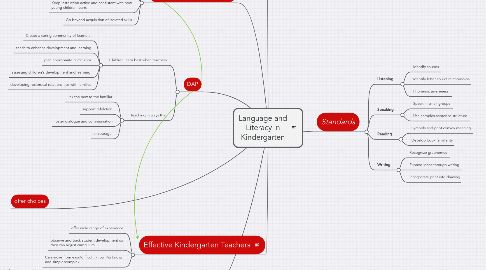
1. offer choices
2. Critical Issues and Policy
2.1. Clear articulation of the language and literacy goals and standards for the kindergarten year in relationship to social, emotional, physical, and cognitive development.
2.2. The establishment of strong and equal partnerships with prekindergarten and primary grade educaiors
2.3. careful consideration for the need fro full day or half day kindergarten with a focus on high quality learning environments.
2.4. Increased atyenyion o qualiy home school connections that foster partnership and mutual goals
2.5. Accountability programs that are developmentally appropriate, efficient and inform insturction
2.6. high quality, ongoing profession development in literacy learning and teaching.
3. Balanced Curriculum
3.1. Scaffold instruction
3.2. balance between elicit and informal learning
3.3. diversify instruction to meet individual needs
3.4. Keep instruction active and consistent with how young children learn.
3.5. Go beyond acquisition of isolated skills
4. Oral Language is the foundation
4.1. Provides children with a sense of words and sentences
4.1.1. Essays / Articles
4.1.2. Books
4.2. Means by which children demonstrate understanding of the meanings of words and written material.
4.2.1. Textbooks
4.2.2. Essays / Articles
4.2.3. Theses
4.3. By age 5 or 6 children know sounds in their language sentence structure and meaning of many words.
5. Effective Kindergarten Teachers
5.1. offer wide range of experience
5.2. observe and track student development so they can adjust curriculum
5.3. Can move from easy/difficult, known/unknown and simple/complex
6. DAP
6.1. Children learn best when teachers
6.1.1. Create a caring community of learners
6.1.2. teach to enhance development and learning
6.1.3. plan appropriate curriculum
6.1.4. assessing children's development and learning
6.1.5. developing reciprocal relationships with families
6.2. Teaching in ways that
6.2.1. link the new to the familiar
6.2.2. support refelction
6.2.3. foster dialogue and communiation
6.2.4. encourage
7. Standards
7.1. Listening
7.1.1. Identify sounds
7.1.2. Identify letter sound relationships
7.1.3. Phonemic awareness
7.2. Speaking
7.2.1. Speak in small groups
7.2.2. Use complex sentence structure
7.3. Reading
7.3.1. Symbols and print convey meaning
7.3.2. Develop book familiarity
7.4. Writing
7.4.1. Recognize graphemes
7.4.2. Express ideas through writing
7.4.3. Incorporate print into drawing
